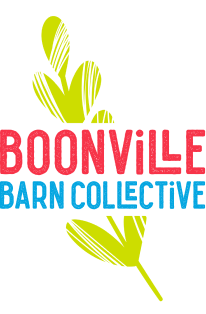We’ve made it to week 3 of bean month here at Boonville Barn Collective. Some of my friends have been concerned with the amount of beans I've consumed this month, but I'm having fun over here.
This week we're diving into Tepary Beans - an indigenous bean from the Southwest/Mexico. It's a heavy producer here on the farm that people tend to shy away from because they have truly never seen anything like it before. I'm excited to enlighten you on these delicious beans.
The Tepary: An Indigenous Climate Smart Bean
Tepary beans have been grown for thousands of years in North America. The beans have been found in archeological sites dating to 2,500 years old in Tehuacán Valley of Mexico and 1,000 year old sites of the Hohokam people in Arizona. There’s a vast world of Tepary beans out there. Some are reminiscent of little speckled eggs while others look like tiny rocks [Check out Native Seeds SEARCH to see some of the different varieties out there]. The people with some of the closest ties to Tepary beans are the Tohono O’odham tribe, whose homeland spans the Sonoran desert in Arizona and Mexico.
According to Tohono O’odham legend, White Tepary beans were scattered across the night sky to create the Milky Way.
Tepary beans are native to the desert. They thrive under water-stressed conditions and will be more productive if they experience drought as they mature. Think of the desert - it’s a harsh environment with limited and sporadic rain events, dry soils, and intense heat. These beans were scattered at the mouths of arroyos (seasonal creek beds that flood during monsoon rains) at the start of the summer monsoon season where water diversions were set up to irrigate the beans. They develop deep roots to take up any bit of water in the soil and are able to find water deeper than common bean varieties can. These bean plants have thin leaves that come to strong points compared to the broad leaves of other beans. Their pods are small and flat and very full of beans.
One of the really special traits of Tepary beans is that these beans can move into the “seed setting” stage (where they start to produce the actual beans) at temperatures over 105 degrees. Other beans are generally unable to do so at temperatures above 80-85 degrees (plants become too stressed and the flowers they develop will die and not produce seed). These characteristics make these beans a perfect example of climate-smart eating. If we want to make meaningful climate impacts with the food we eat, we have to look at crops like this that are able to thrive in conditions that others can't.
Tepary beans are higher in fiber and protein than other beans and have a low glycemic index. According to Ramona Farms (a Native source for Tepary Beans), there’s 23 grams of protein, 56 grams of fiber, and 70% of your daily calcium, and 150% of your daily iron in half a cup of these dry beans. They are really an indigenous superfood.

For a time, these beans were grown all across the Midwest and Southwest, used as both a bean crop to harvest and as a cover crop. In 1918, California had 17,000 acres of Tepary beans in production. When public preference shifted towards other beans, their production plummeted. Cultural production of Tepary beans by the Tohono O’odham fell again during WWII when tribe members joined the military or started working on cotton plantations. But, these beans are coming back as an important traditional foodway based on cultural importance and their incredible health benefits.
This will be our third season growing two different varieties of Tepary beans. These beans were introduced to me by Mike Reeske (the same guy who provided seed for Southwest Gold and Tigers Eye beans). If you look at them, the Tan and Brown Teparies have 2 distinct shapes. The Tan is flat (a more typical Tepary share) and the Brown has more rounded edges like a common bean. In digging deeper into Tepary beans, I’ve learned that the Tan Tepary is actually known as S’oam Pawi or W'pegi bawi and is from Menagers Dam, a Tohono O'odham community east of Organ Pipe National Monument on the Arizona - Mexico border. The Brown Tepary is a variation that came out of Mike’s field of Black Tepary beans. The original Black Tepary beans were of the more typical shape but this dark brown variation ended up growing well and tasting good! I asked Mike if he named it. He told me that it was a completely new variety of Tepary beans but does not have a name.
We were drawn to growing Tepary beans as we faced a winter with little rainfall and were wondering how much of our acreage we’d have enough water to grow. If the last 5 years have taught us anything, having a forward-thinking plan for crop production under harsher growing conditions is absolutely necessary for survival. And Tepary beans fit into this plan for our farm.
The Tan Tepary beans are being featured here in Mendocino County at the Fort Bragg Unified School District for their Harvest of the Month program this month, too!
Tepary Bean Flavors
Tan Tepary: According to Ramona Farms, "This variety has a subtle earthy flavor with an almost nut-like taste and an aroma that is reminiscent of the smell of a summer rain on the desert. Tepary beans are packed with nutrients and when cooked for several hours tepary beans retain their shape and firmness, yet make a deliciously sweet and savory gravy that one can pour off and drink.” When I cooked them, the Tan Tepary beans got creamy and were nutty and sweet.
Brown Tepary: This had a much more distinct earthy flavor and smell compared to the Tan. It was also a bit less creamy. I think these work better with umami flavors and in places where you are really replacing meat in a dish.
How to Cook Tepary Beans
Tepary beans take a bit longer to cook than our other beans, but are incredibly forgiving if overcooked - they keep their shape! And while they aren’t the same legume as a lentil, I do find myself using them similarly. Mike told me he spent a lot of time convincing chefs to start cooking Tepary beans with one of their benefits being that you can reheat them and they don’t fall apart!
I cooked the Brown and Tan Tepary beans side by side on the stove to see how long they each would take. I followed my regular bean cooking method of boiling for 15 minutes and then simmering till soft and creamy. The Tan Tepary beans were finished after 1 hour and 13 minutes of cooking and the Brown Tepary beans were finished after 1 hour and 35 minutes of cooking. But! This isn’t how I usually cook tepary beans.
Tepary beans are the only one of our beans that I like to cook in my instant pot instead of on the stove. I’ve found that 40-45 minutes on high pressure in the instant pot will lead to really good Tepary beans.
If you are new to cooking dry beans, you can find my method here on our site.
Recipes for this Week: Tepary Beans
The great thing about beans is that they are pretty versatile when it comes to swapping beans in and out. Tepary beans are no exception.
They are a great addition to soups and I’ve also seen them used in hummus as a swap for chickpeas.
And just because my brain sees them and is like "these small beans look like lentils!" I like to use them as I would in lentil salads or recipes where you want the lentils to hold their shape (I wouldn't swap them for a recipe with red lentils).
Here’s a mix of ways we’ve eaten Tepary beans and how we will enjoy them this week (or ate them last week to prepare!)
1. Burrata with Lentils (Sub for Tepary Beans!) and Basil Vinaigrette from Smitten Kitchen: I had a moment of panic one night last week when I had been making so many different bean recipes, Gideon was out of town, my fridge was fun, and I needed help eating everything. My friend Abi came over on a moments notice to help eat this warm bowl of Tepary beans and it was SO GOOD.
While it's not really the epitome of winter vegetables on hand, it was a perfect break from winter flavors. In addition to the zucchini, I added a small handful of mushrooms I had on hand and ample Piment d’Ville while the vegetables were cooking. I warmed up the Tan Tepary beans I had already cooked and mixed it all together. For the basil vinaigrette, I defrosted some pesto I made this summer as the base. The hunk of burrata mimics the creaminess of a poached egg and I have to say I prefer the cheese to egg for something like this! It was quick and very filling!

2. Acorn Squash and Tepary Bean Stew: We had this last week with our neighbors. I used butternut squash instead of acorn (I think the flavor is better!) and seared some chicken thighs in the pan and braised them in the soup while it was cooking. I seasoned the chicken with Piment d'Ville and added our Calabrian chile flakes to the stew towards the end. I opted out of adding the vanilla bean (just wasn't my vibe!) and also added carrots because I thought I saw them in the ingredient list.

|
3. Tepary Beans with Chile Agave Glaze: We ate these beans alongside a piece of pan-seared Flank Steak and a salad! This was the first way I tried our Tepary beans a few years ago and it has a fun sweetness that baked beans have but is a bit less rich (in a good way!). I used Guajillo chile powder.
Apologies that this recipe requires a NYT Cooking subscription. But basically sauté some onion, add 2 cups of cooked Tepary beans and their juices, some agave syrup, Guajillo chile powder, and simmer till the liquid thickens. Top with oregano. The earthiness of the Brown Tepary beans worked well with the sweetness of agave and smokiness of guajillo chile powder.
|

4. NYT also has a recipe for a crisp and summery Tepary Bean Salad, but here’s a basic description: mix 2 cups of cooked Tepary beans with chopped red onion, cooked corn, diced bell peppers, cilantro, and diced jalapeño and dress with a cumin vinaigrette made with apple cider vinegar, dijon mustard, cumin, garlic, and olive oil.
5. Naanwiches with Tepary bean and Feta Mash: Here’s another recipe where I’m swapping Tepary beans in. I’m also opting to use store bought naan for the sandwiches because sometimes you just don’t have time! It’s a hearty lunch that my friend Clare says she makes often.

6. Frijoles Fronterizos (Border Beans): This recipe for a bowl of Tepary beans with chorizo, bacon, chiles, and tomatoes seems like the perfect thing for another rainy night this month. Tucked into a tortilla or eaten over rice, it seems flavorful, hearty, and super comforting.
7. Tepary Bean Nachos: I’m also including this recipe for Tepary Bean Nachos from Chef Denella Belin, a member of the Dine’ Navajo Nation who was working as a sous chef at a restaurant in the Tohono O’odham Nation. These nachos are inspired by the Tohono O’odham tepary beans.
A Note on Agriculture Policy:
I found a lot of this information about Tepary Beans from the USDA Natural Resource Conservation Service’s plant guides. The NRCS is currently facing a potential $8.9 Billion in funding cuts with the current administration's attempt to curtail government spending.
This includes programs that farms in red states and blue states take advantage of like the Conservation Reserve Program (provides a yearly rental payment to farmers who remove environmentally sensitive land from agricultural production and plant species that will improve environmental health and quality), Conservation Stewardship Program (helps you build on your existing conservation efforts while strengthening your operation), Environmental Quality Incentive Program (NRCS’ flagship conservation program that helps farmers, ranchers and forest landowners integrate conservation into working lands), as well as various watershed protection and air quality programs just to name a few.
CRP, CSP, and EQIP account for about 80% of the proposed funding cuts at NRCS. These programs are programs that directly PAY FARMERS for the environmentally beneficial work they are doing on their farms. CSP and EQIP are reimbursement programs which means farms that had these contracts have already paid for and implemented the projects and are awaiting payment from USDA. Losing just these 3 programs will have incredibly damaging effects on farmers' bottom lines. The NRCS is staffed by incredibly smart scientific field agents who provide impartial technical assistance to farmers across the country.
Next Sunday we'll be cooking Anazape.



